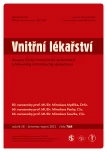Contrast nephropathy and prevention
Authors:
V. Teplan 1,2
Authors‘ workplace:
Klinika nefrologie Transplantcentra IKEM Praha, přednosta prof. MUDr. Ondřej Viklický, CSc.
1; Subkatedra nefrologie IPVZ Praha, vedoucí prof. MUDr. Vladimír Teplan, DrSc.
2
Published in:
Vnitř Lék 2012; 58(7 a 8): 93-96
Category:
80th Birthday MUDr. Miroslav Mydlík, DrSc.
Overview
Contrast-induced nephropathy (CIN) is a serious complication of radio-contrast vascular examination, mainly in high-risk patients with decreased renal function. In prevention, we have to know risk factors strongly influencing follow-up. All potential nephrotoxic drugs should be excluded. We recommend adequate intravenous hydration, supplemented individually with bicarbonate and N-acetylcystein. Studies designed to explore options in CIN prevention included trimetazidine (TMZ) belonging to cytoprotective antiischemic agents used in the treatment of angina pectoris. Trimetazidine affects reperfusion at the cellular and mitochondrial levels, and has antioxidant and metabolic activity via several mechanisms at the cellular level, that is, it shows characteristics making it a clear candidate for CIN prophylaxis. In serious cases hemofiltration could be used to help eliminate contrast solution as soon as posible. Beside serum creatinine, NGAL detected in urine may help in early diagnosis of tubular damage.
Key words:
contrast-induced nephropathy – risk patients – hydratation – trimetazidine – NGAL
Sources
1. Šochman J Poškození ledvin kontrastními látkami. In: Teplan V et al. Akutní poškození a selhání ledvin v klinické medicíně. Praha: Grada 2010: 303–324.
2. Zemánek D. Kontrastem navozená nefropatie. Cor Vasa 2009; 51 (Suppl 1): 69–73.
3. Onbasili AO, Yeniceriglu Y, Agaoglu P et al. Trimetazidine in the prevention of contrast-induced nephropathy after coronary procedures. Heart 2007; 93: 698–702.
4. Mehran R, Nikolsky E Contrastinduced nephropathy: definition, epidemiology, and patients at risk. Kidney Int Suppl 2006; 100: S11–S15.
5. Lasser EC, Lyon SG, Berry CC. Reports on contrast media reactions: analysis of data from reports to the US Food and Drug Administration. Radiology 1997; 203: 605–610.
6. Barrett BJ, Parfrey PS Preventing nephropathy induced by contrast medium. N Engl J Med 2006; 354: 379–386.
7. McCullough PA, Wolyn R, Rocher LL et al. Acute renal failure after coronary intervention: incidence, risk factors, and relationship to mortality. Am J Med 1997; 103: 368–375.
8. Katholi RE, Woods Jr WT, Tailor GJ et al. Oxygen free radicals and contrast nephropathy. AmJ Kidney Dis 1998; 32: 64–71.
9. Zager RA, Johnson AC, Hanson SY Radiographic contrast mediainduced tubular injury: Evaluation of oxidant stress and plasma membrane integrity. Kidney Int 2003; 64: 128–139.
10. Rihal CS, Textor SC, Grill DE et al. Incidence and prognostic importance of acute renal failure after percutaneous coronary intervention. Circulation 2002; 105: 2259–2264.
11. Caldicott WJ, Hollenberg NK, Abrams HL. Characteristics of response of renal vascular bed to contrast media. Evidence of vasoconstriction induced by reninangiotensin system. Invest Radiol 1970; 5: 539–547.
12. Russo D, Minutolo R, Cianciaruso B et al. Early effects of contrast media on renal hemodynamics and tubular function in chronic renal failure. J Am Soc Nephrol 1995; 6: 1451–1458.
13. Rich MW, Crecelius CA. Incidence, risk factors, and clinical course of acute renal insufficiency after cardiac catheterization in patients 70 years of age or older: a prospective study. Arch Intern Med 1990; 150: 1237–1242.
14. Levy EM, Viscoli CM, Horwitz RI. The effect of acute renal failure on mortality. A cohort analysis. JAMA 1996; 275: 1489–1494.
15. Bartholomew BA, Harjai KJ, Dukkipati S et al. Impact of nephropathy after percutaneous coronary intervention and a method for risk stratification. Am J Cardiol 2004; 93: 1515–1519.
16. Lindsay J, Canos DA, Apple S et al. Percutaneous coronary interventionassociated nephropathy foreshadows increased risk of late adverse events in patient with normal baseline serum creatinine. Catheter Cardiovasc Interv 2003; 59: 338–343.
17. Brar SS, Shen AY, Jorgensen MB et al. Sodium bicarbonate vs sodium chloride for the prevention of contrast medium-induced nephropathy in patients undergoing coronary angiography: a randomized trial. JAMA 2008; 300: 1038–1046.
18. Mueller C, Buerkle G, Buettner HJ et al. Prevention of contrast mediaassociated nephropathy: randomized comparison of 2 hydration regimens in 1620 patients undergoing coronary angioplasty. Arch Intern Med 2002; 162: 329–336.
19. Tepel M, van der Giet M, Schwarzfeld C et al. Prevention of radiographic-contrast-agent-induced reductions in renal function by acetylcysteine. N Engl J Med 2000; 343: 180–184.
20. Spargias K, Alexopoulos E, Kyrzopoulos S et al. Ascorbic acid prevents contrast-mediated nephropathy in patients with renal dysfunction undergoing coronary angiography or intervention. Circulation 2004; 110: 2837–2842.
21. Khanal S, Attallah N, Smith DE et al. Statin therapy reduces contrast-induced nephropathy: an analysis of contemporary percutaneous interventions. Am J Med 2005; 18: 843–849.
22. Stone GW, Mc Cullough P, Tumlin J et al. Fenoldopam mesylate for the prevention of contrast-induced nephropathy: a randomized controlled trial. JAMA 2003; 290: 2284–2291.
23. Marzili M Cardioprotective effects of trimetazidine: a review. Curr Med Res Opin 2003; 19: 661–672.
24.Teplan V. Možnost prevence kontrastní látkou indukované nefropatie po koronarografii trimetazidinem: příspěvek nefrologa. Cor Vasa 2011; 53: 1–3.
25. Gunal AI, Celiker H, Ustundag B et al. The effect of oxidative stress inhibition with trimetazidine on the peritoneal alterations induced by hypertonic peritoneal dialysis solution. J Nephrol 2003; 16: 225–230.
26. Aygen B, Celiker H, Dogukan A et al. The effect of trimetazidine on lipid peroxidation with endstage renal disease. Methods Find Exp Clin Pharmacol 2008; 30: 757–760.
27. Zoppo A, Faggiotto A, Redaelli L et al. Trimetazidine counteracts tacrolimus nephrotoxicity in a hypertensive liver transplant patients. Transplantation 1999; 68: 1211–1215.
28. Singh D, Chopra K. Effect of trimetazidine on ischemia/reperfusion injury in rats. Pharmacol Res 2004; 50: 623–629.
29. Marenzi G, Marana I, Lauri G et al. The prevention of radio contrast-agent-induced nephropathy by hemofiltration. N Engl J Med 2003; 349: 1333–1340.
Labels
Diabetology Endocrinology Internal medicineArticle was published in
Internal Medicine

2012 Issue 7 a 8
Most read in this issue
- Myocardial infarction the young – our results and experience
- An anaesthesiologist’s perspective on requirements for pre-surgery examinations
- Megakaryopoesis and platelet genesis
- Aldosterone antagonists in chronic heart failure treatment
